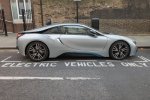Does Voltage Equal Speed?
by Jacob Owens
(Sharon, TN)

Excellent lightning picture
I'm thinking about converting a five-speed Toyota to electric. If I put in a DC motor, how fast will it go? How many volts are the systems, usually, and can I just add more voltage if I want more speed?
Hi, Jacob!
I couldn't resist the lightning picture. It has nothing to do with your question, except for the voltage; )
Let's see:
- Five speed Toyota, good...lightweight, manual transmission. I approve, hehe.
- DC motor, how fast will it go? Freeway fast. Exactly how fast depends on your next question...
- Voltage. How many volts do these typically have? Usually between 100 and 150 volt systems, in multiples of 6, 8, or 12 (because that's what size batteries you can get). 120 volts is really common, so is 144.
- Do more volts mean more speed? Yes, pretty much. The voltage determines how many amps you can draw from the battery at a time, which determines your acceleration.
Regards,
Lynne


